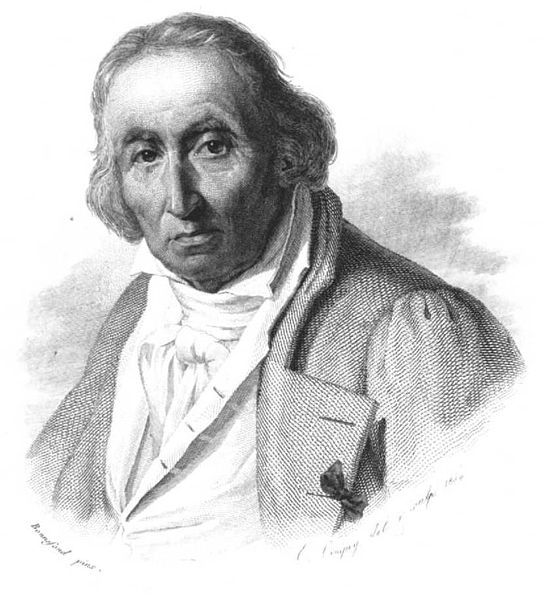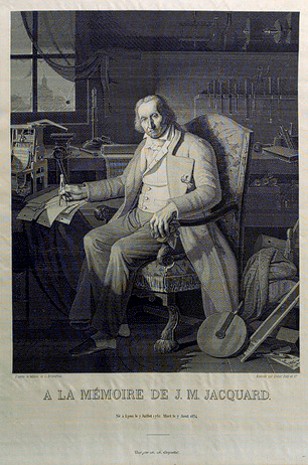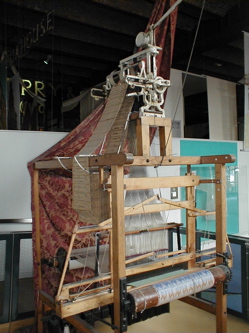<Back to Index>
- Inventor Joseph Marie Charles Jacquard, 1752
- Writer Lion Feuchtwanger, 1884
- General of the Union Cavalry Alfred Pleasonton, 1824
PAGE SPONSOR



Joseph Marie Charles dit (called or nicknamed) Jacquard (7 July 1752 (Lyon, France) – 7 August 1834 (Oullins, France)) played an important role in the development of the earliest programmable loom (the "Jacquard loom"), which in turn played an important role in the development of other programmable machines, such as computers.
Jean Jacquard’s name was not really “Jacquard”. In his grandfather’s generation, several branches of the Charles family lived in Lyon’s Couzon - au - Mont d’Or suburb (on Lyon’s north side, along the Saône River). To distinguish the various branches, they were given nicknames; Joseph’s branch was dubbed the “Jacquard” Charles. Thus, Joseph’s grandfather was “Barthélemy Charles dit [called] Jacquard”.
Joseph Marie Charles dit Jacquard was born in Lyon, France on 7 July 1752. He was one of nine children of Jean Charles dit Jacquard, a master weaver of Lyon, and his wife, Antoinette Rive. However, only Joseph and his sister Clémence (born 7 November 1747) survived to adulthood. Although his father was a man of property, Joseph received no formal schooling and remained illiterate until he was 13. He was finally taught by his brother - in - law, Jean - Marie Barret, who ran a printing and bookselling business. Barret also introduced Joseph to learned societies and scholars.
His mother died in 1762, and when his father died in 1772, Joseph inherited his father’s house, looms and workshop as well as a vineyard and quarry in Couzon - au - Mont d’Or. Joseph then dabbled in real estate. In 1778, he listed his occupations as master weaver and silk merchant.
On 26 July 1778, Joseph married Claudine Boichon. She was a middle class widow from Lyon who owned property and had a substantial dowry. However, Joseph soon fell deeply into debt and was brought to court. To settle his debts, he was obliged to sell his inheritance and to appropriate his wife’s dowry. Fortunately, his wife retained a house in Oullins (on Lyon’s south side, along the Rhone River), where the couple resided. On 19 April 1779, the couple had their only child, a son, Jean Marie.
By 1800, Joseph began to dabble in inventing: a treadle loom in 1800, a loom to weave fishing nets in 1803, and starting in 1804, the “Jacquard” loom, which would weave patterned silk automatically. However, none of his inventions operated well and thus were unsuccessful.
In 1801, Jacquard exhibited his invention at the industrial exhibition in Paris; and in 1803 he was summoned to Paris and attached to the Conservatoire des Arts et Metiers. A loom by Jacques de Vaucanson on display there suggested various improvements in his own, which he gradually perfected to its final state. Although his invention was fiercely opposed by the silk weavers, who feared that its introduction, owing to the saving of labour, would deprive them of their livelihood, its advantages secured its general adoption, and by 1812 there were 11,000 Jacquard looms in use in France. The loom was declared public property in 1806, and Jacquard was rewarded with a pension and a royalty on each machine.
Jacquard died at Oullins (Rhône), 7 August 1834. Six years later a statue was erected to him in Lyon, on the site where his 1801 exhibit loom was destroyed. The Jacquard Loom is a mechanical loom that
has holes punched in pasteboard, each row of which corresponds to one
row of the design. Multiple rows of holes are punched on each card and
the many cards that compose the design of the textile are strung
together in order. It is based on earlier inventions by the Frenchmen Basile Bouchon (1725), Jean - Baptiste Falcon (1728) and Jacques Vaucanson (1740). In order to discuss the Jacquard loom, some basic knowledge of weaving is
necessary. In order to make a strip of cloth, parallel threads (the
“warp”) are stretched across a rectangular frame. To make a plain piece
of cloth, every other warp thread is raised slightly. A thread (the
“weft thread”) is then passed (at a right angle to the warp) through
the space (the “shed”) between the lower and the upper warp threads.
The raised warp threads are then lowered and the previously lower warp
threads are raised, and the weft thread is then passed through the shed
in the opposite direction. The process can then be repeated indefinitely. However,
by raising different warp threads during weaving, it is possible to
make fabrics of different textures or to vary the texture, or even the
color, of the cloth in order to create patterns or designs. When
elaborate patterns or designs were to be woven manually, selecting the
warp threads that were to be raised became a slow, complicated
procedure that was subject to error. Jacquard’s loom was intended to
automate this process. Jacquard was not the first man to try to automate the process of weaving. In 1725 Basile Bouchon invented
an attachment for draw looms which used a broad strip of punched paper
to select the warp threads that would be raised during weaving. Specifically, Bouchon’s innovation involved a row of hooks. The curved portion of
each hook snagged a string that could raise one of the warp threads,
whereas the straight portion of each hook pressed against the punched
paper, which was draped around a perforated cylinder. Whenever the hook
pressed against the solid paper, pushing the cylinder forward would
raise the corresponding warp thread; whereas whenever the hook met a
hole in the paper, pushing the cylinder forward would allow the hook to
slip inside the cylinder and the corresponding warp thread would not be
raised. Bouchon’s loom was unsuccessful because it could handle only a
modest number of warp threads. By
1737, a master silk weaver of Lyon, Jean Falcon, had increased the
number of warp threads that the loom could handle automatically. He
developed an attachment for looms in which Bouchon’s paper strip was
replaced by a chain of punched cards, which could deflect multiple rows
of hooks simultaneously. Like Bouchon, Falcon used a “cylinder”
(actually, a four - sided perforated tube) to hold each card in place
while it was pressed against the rows of hooks. His loom was modestly successful: about 40 such looms had been sold by 1762. In 1741, Jacques de Vaucanson, a French inventor who designed and built automated mechanical toys, was appointed inspector of silk factories. Between 1747 and 1750, he
tried to automate Bouchon’s mechanism. In Vaucanson's mechanism, the
hooks that were to lift the warp threads were selected by long pins or
"needles", which were pressed against a sheet of punched paper that was
draped around a perforated cylinder. Specifically, each hook passed at
a right angle through an eyelet of a needle. When the cylinder was
pressed against the array of needles, some of the needles, pressing
against solid paper, would move forward, which in turn would tilt the
corresponding hooks. The hooks that were tilted would not be raised, so the warp threads that were snagged by those hooks would remain in place; however, the hooks that were not tilted,
would be raised, and the warp threads that were snagged by those hooks
would also be raised. By placing his mechanism above the loom,
Vaucanson eliminated the complicated system of weights and cords (tail
cords, simple, pulley box, etc.) that had been used to select which
warp threads were to be raised during weaving. Vaucanson also added a
ratchet mechanism to advance the punched paper each time that the
cylinder was pushed against the row of hooks. However, Vaucanson’s loom was not successful. In
order to stimulate the French textile industry, which was competing
with Britain’s industrialized textile industry, Napoleon Bonaparte placed large orders for Lyon’s silk, starting in 1802. In 1804, at
the urging of Lyon silk merchant Gabriel Detilleu, Jacquard studied
Vaucanson’s loom, which was stored at the Conservatoire des Arts et
Métiers in Paris. By
1805 Jacquard had eliminated the paper strip from Vaucanson’s mechanism
and returned to using Falcon’s chain of punched cards. The
potential of Jacquard’s loom was immediately recognized. On April 12,
1805, emperor Napoleon and empress Josephine visited Lyon, and during
their tour, they viewed Jacquard’s new loom. On April 15, 1805, the
emperor granted the patent for Jacquard’s loom to the city of Lyon. In
return, Jacquard received a lifelong pension of 3,000 francs;
furthermore, he received a royalty of 50 francs for each loom that was
bought and used during the period from 1805 through 1811.